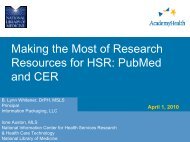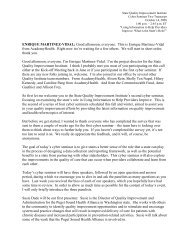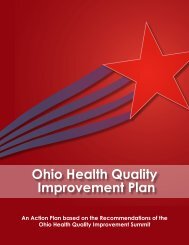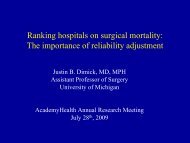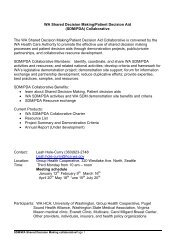Caring for Mom & Neglecting Yourself?
Caring for Mom & Neglecting Yourself?
Caring for Mom & Neglecting Yourself?
- No tags were found...
Create successful ePaper yourself
Turn your PDF publications into a flip-book with our unique Google optimized e-Paper software.
<strong>Caring</strong> <strong>for</strong> <strong>Mom</strong> and <strong>Neglecting</strong><strong>Yourself</strong>?The Health Effects of <strong>Caring</strong> <strong>for</strong> anElderly ParentNorma B. CoeCenter <strong>for</strong> Retirement Research at Boston CollegeCourtney Harold Van HoutvenVA and Duke University Medical CentersFunding: Network <strong>for</strong> Studying Pensions, Aging and Retirement, Tilburg UniversityJohn A. Hart<strong>for</strong>d Foundation
Children and In<strong>for</strong>mal Care• Adult children most common source in terms of #, and maybe increasing• Differential life expectancy; Increased divorce rates• Baby boomer aging• IC negatively affects spousal caregiver health• Key differences between children and spousal caregivers• Age and initial health• Less financial and emotional dependence• Labor <strong>for</strong>ce participation1
Research Questions•What are the health effects of initial caregiving on adultchildren?•What are the health effects of continued caregiving?•Are health effects persistent?3
Why Should We Care?If fully rational agents• Child does not bear full cost of health investments• Health insurance•If publicly provided, affects future insurance provision• Social safety net•Pay <strong>for</strong> health declines if stop work due to caregivingIrrational agents• Adult child may underestimate health effects4
Data• Health and Retirement Study• 1992-2004 (2-years) panel• born between 1931-1941• only a (not co-residing) mother alive• Two main samples• Non-caregivers: N=8007; individuals=3316• Caregivers: N=2557; individuals=1467• Separated by marital status and gender5
6Health Measures on Adult Children• Depressive symptoms (CES-D8, 0-8)• Self-rated health – very good/excellent health vs. other• High blood pressure ever• Heart condition since last wave
HRS Caregiving QuestionsDid you spend a total of 100 or more hours (since PreviousWave Interview Month-Yeah/in the last two years) helping your(parents/mother/father) with basic personal activities likedressing, eating, and bathing?Did you spend a total of 100 or more hours (since PreviousWave Interview Month-Year/in the last two years) helping your(parents/mother/father) with other things such as householdchores, errands, transportation, etc.?7
8Health Effects of CaregivingH c,t+2 = α + β 1 H c,t + β 2 A c,t+2,t + β 3 H p + β 4 X c + µH c : health (depression, SRH, heart condition, HBP)A c : In<strong>for</strong>mal careH p : Age, education (both parents), and indicator variables <strong>for</strong>needing help with activities of daily living, having diagnosedmemory problemX c : Age, age squared, number of children, race, <strong>for</strong>eign-born,education categories, ln(net worth), work status
9Potential EndogeneityStart caregiving• Least attachment to the labor <strong>for</strong>ce – related to health?Related to bargaining among siblings?• Minimum level of health?• Use FAMILY CHARACTERISTICS as instrumentalvariables; strong <strong>for</strong> marriedsEnd of caregiving• Stop caregiving due to own health declines?• Use DEATH OF MOTHER as instrumental variable; strong<strong>for</strong> all groups
10Methods• Appropriate model?• OLS• IV• IV FE• Accounts <strong>for</strong> repeated observations over time• Arellano-Bond estimator• Accounts <strong>for</strong> the correlation of prior health with theerror term
11Descriptive Statistics – Adult ChildExplanatory Variables Caregivers Non-CaregiversDemographic characteristicsFemale 0.64 0.55Is an eldest daughter 0.33 0.27Married 0.73 0.75Age 57.69 54.76Education (years) 12.82 12.31Number of children 3.42 3.38Number of grandkids 4.28 2.32Work/Wealth MeasuresFull-time work 0.45 0.51At least part-time work 0.54 0.57Net worth 297,869 249,864
12Descriptive StatisticsCaregivers Non-CaregiversHealth MeasuresDepressive symptoms 1.16 0.27Heart condition 0.09 0.11High blood pressure 0.22 0.36Self-reported very good or excellent health 0.53 0.53Mother’s CharacteristicsMother needs ADL help 0.30 0.23Mother has doctor diagnosed memory problem 0.04 0.005Mother’s age 87.40 79.55Mother’s education (years) 10.04 9.73Family Structure Instrument ListNumber of girls 1.89 2.23Number of boys 1.64 1.97Eldest child in family is female 0.55 0.53Number of siblings’ kids 6.46 8.04
13Results - PreviewDifferent health effects between initial caregivers andcaregivers who continued caregivingNegative health effects <strong>for</strong> three out of four subgroups ofadult children; single women appear to be unaffected.
Health Effects: First 2 Years CaregivingMarried WomenCES-D8 tVery Good Health orBetter tHigh BloodPressure tHeart Condition tOLS OLS Probit ProbitCaregiving t 0.1665** 0.0044 0.0084 0.0643(0.0731) (0.0167) (0.0751) (0.1245)Observations 3310 3308 3309 3309Individuals 1403 1403 1403 1403R-squared 0.24 0.39Married MenCaregiving t 0.0269 -0.0202 0.0383 0.1073(0.0647) (0.0203) (0.1142) (0.1285)Observations 2993 2990 2993 2987Individuals 1239 1239 1239 1239R-squared 0.19 0.3414
15Health Effects – Persistence of EffectsMarried women: BadTWO YEARS OUTLess likely to be in very good or better healthMore likely to have high blood pressureFOUR YEARS OUTIncrease in depressive symptomsLess likely to be in very good or better healthMore likely to have high blood pressure
16Health Effects – Continued CaregivingMarried women: BAD• 47% increase in depressive symptoms• 10% decrease in the probability of reporting very good orexcellent healthMarried men: MIXED• 83% increase in depressive symptoms• 17% MORE likely to report in very-good or excellenthealth.Single men: BAD• 40% more likely to have a new heart condition.
17Health Effects – Persistence of EffectsTWO YEARS OUT: BADDepression effect persists <strong>for</strong> married womenHeart conditions persists <strong>for</strong> single menNote: Regression also includes individual level variables, parent-level variables, and year of interview indicator. Standarderrors are clustered on the individual to account <strong>for</strong> multiple observations of the same person.
18Conclusions• Negative physical and mental health effects of caregiving,both <strong>for</strong> caregivers just starting and continuing caregivers• Fleeting and some persistent, especially depressionPolicy / Cost Implications• Ignoring the negative health effects overstates the publicand private costs savings from in<strong>for</strong>mal care provided byadult children (JLoS, 2001; VH & Norton, 2004; 2008; CS,2005; BLL, 2007; Bonsang, 2009)• Net benefits of in<strong>for</strong>mal care to society moregenerally
20Extensions• Health effects of in<strong>for</strong>mal care limited to one generation ormultiple?• Married adult households• Examine care to in-law vs parent?• Differentiate between caregiving and new survival/healthin<strong>for</strong>mation• Work and Wealth Effects• Work and Income as an outcome• Inter-vivos transfers and inheritances




